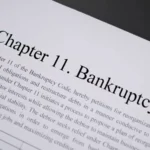Navigating Texas Business Bankruptcy Laws
At Ritter Spencer Cheng PLLC, we help Texas businesses understand and manage the challenges of bankruptcy. As a law firm experienced in Texas business bankruptcy laws, our goal is to give businesses clear, practical guidance when facing financial difficulties.
Bankruptcy is a legal process governed by federal law. It can help reduce or eliminate business debt, stop creditor harassment, and protect certain assets. When handled correctly, it gives business owners a way to rebuild their business operations or close down responsibly. For many, filing bankruptcy is the most practical option to resolve overwhelming unsecured debts, secured loans, hard-money loans, real estate loans, lines-of-credit loans, credit card debt and more.
Understanding Bankruptcy: What It Means for Texas Businesses
Bankruptcy cases are handled by a federal court and are initiated by filing a bankruptcy petition. Business owners, especially sole proprietors, may be personally responsible for business debt, depending on how the business entity is structured. It’s critical to understand how the Bankruptcy Code applies to your unique situation, including how Texas bankruptcy exemptions or federal exemptions may protect personal assets.
Texas bankruptcy laws allow for various exemptions, including the Texas homestead exemption, which can safeguard your home from liquidation. Working with an experienced bankruptcy attorney ensures these rights are fully used.
At Ritter Spencer Cheng PLLC, we view bankruptcy not as a failure but as a strategic decision for business restructuring or orderly closure. We assist our clients in making informed decisions, comprehending the impacts on assets and liabilities, and skillfully navigating the complexities of bankruptcy law, from filing petitions to understanding court outcomes.
Bankruptcy Options for Texas Businesses
In Texas, businesses have multiple bankruptcy options to address specific financial circumstances. Understanding these options is essential to choosing the most appropriate financial recovery or restructuring path.
Chapter 7 Bankruptcy
Often referred to as liquidation, Chapter 7 bankruptcy is used when a business cannot continue. A court-appointed trustee sells nonexempt business assets and uses the proceeds to pay secured creditors and unsecured debts. This type of bankruptcy is typically best for corporations, partnerships, or LLCs that have no realistic means of staying open. Depending upon the amount of consumer debt a person has, sole proprietors must meet a means test to qualify under Chapter 7.
Chapter 11 Bankruptcy
David Ritter has helped many companies across Texas navigate Chapter 11 bankruptcy, including business reorganizations and court-supervised debt restructuring. This chapter offers a way for businesses with solid fundamentals but short-term financial trouble to remain open while negotiating with creditors. A corporate bankruptcy judge oversees the case while the debtor proposes a repayment plan. Any business entity—including corporations, partnerships, and sole proprietors—may qualify to file Chapter 11.
Chapter 13 Bankruptcy
Available only to individuals and sole proprietorships, Chapter 13 bankruptcy involves a structured repayment plan over three to five years. As of 2025, eligibility requires that secured debt not exceed $1,395,875 and unsecured debt not exceed $465,275. This option is not available for corporations or partnerships but can work for sole proprietors who need to manage both business and personal debts.
Subchapter V of Chapter 11
Created for small business bankruptcy cases, Subchapter V offers a faster and more cost-effective way for eligible businesses to file Chapter 11. As of April 1, 2025, businesses with up to $3,024,725 in total debt may qualify. This path allows owners to maintain control while working with a U.S. Trustee and proposing a simplified plan that does not always require creditor approval. Any business entity may be eligible, as long as it meets the debt limit and is not primarily engaged in owning single-asset real estate.
At Ritter Spencer Cheng PLLC, we guide clients through these options, focusing on unsecured debts, secured creditors, and the bankruptcy process, providing the necessary guidance and representation for informed decision-making.
Chapter 11 Bankruptcy: Restructure and Keep Operating
Under Chapter 11, businesses can continue operating while negotiating with creditors. The process involves submitting a reorganization plan, which may include adjusting monthly payments, renegotiating contracts, or selling assets. Chapter 11 allows flexibility to manage business debt without shutting down. Legal counsel from an experienced bankruptcy lawyer is crucial to navigating the complexities of the Bankruptcy Code.
As a “debtor in possession,” the business retains control over its assets and operations, although the bankruptcy court supervises significant decisions. An automatic stay during Chapter 11 prevents creditor actions, providing breathing space to negotiate and develop the reorganization plan.
Chapter 11 is a vital option for businesses with potential for future profitability. At Ritter Spencer Cheng PLLC, our expertise in guiding businesses through Chapter 11 includes drafting reorganization plans and handling negotiations with creditors and stakeholders.
How to File for Bankruptcy in Texas
Filing bankruptcy begins with understanding the type of bankruptcy that fits your goals. After consulting with a Texas bankruptcy attorney, you’ll gather documentation like your credit report, tax returns, bank account statements, and a full inventory of assets and debts. The bankruptcy petition is then filed with the court.
As soon as the petition is filed, an automatic stay goes into effect, stopping most collection efforts, including garnishments and lawsuits. You’ll be assigned a bankruptcy trustee, and shortly after, attend a meeting of creditors. Depending on the type of bankruptcy filed, you may propose a repayment plan or begin liquidating business assets.
What Happens When You File Bankruptcy in Texas?
Filing bankruptcy triggers the automatic stay, which immediately stops creditor harassment, lawsuits, foreclosures, and wage garnishments. A trustee takes an active role in overseeing the case and distributing payments to creditors if needed. The court, trustee, and your attorney work together to manage the bankruptcy process and resolve outstanding debts.
Each bankruptcy case is unique. Some may result in full discharge of personal debts, while others involve reorganization or partial repayment. Many factors influence the outcome, such as income, types of debt, and exemptions claimed. Certain obligations, like child support or student loans, are generally not dischargeable under the Bankruptcy Code.
The Bankruptcy Process in Texas
The bankruptcy process begins with a consultation with legal counsel to determine the best approach based on your financial situation. After gathering necessary documents, your attorney files the bankruptcy petition in federal court.
Once filed, the automatic stay goes into effect. A court-appointed trustee is assigned to your case, and you’ll attend the meeting of creditors. In reorganization cases, such as Chapter 11 or Subchapter V, you’ll work with the trustee to propose a repayment plan. The court then reviews and either confirms the plan or requests revisions. Once all plan payments or liquidation steps are complete, the court issues a discharge, finalizing the case.
Do You Need a Lawyer?
Bankruptcy law is detailed and always changing. The April 2025 revisions to forms, eligibility thresholds, and court procedures are just one example. Having an experienced bankruptcy attorney by your side ensures compliance with federal law and helps you use all available protections, such as Texas exemptions or federal bankruptcy protections.
Whether you’re dealing with secured debt, unsecured creditors, business restructuring, or personal liability, the right legal advice makes all the difference.
Why Work with Ritter Spencer Cheng PLLC?
We bring years of experience in bankruptcy practice and financial law. From helping small businesses in Dallas and Fort Worth to representing larger business entities across Texas, we guide clients through the bankruptcy process with clarity and professionalism.
You can rely on our team for:
- Guidance on all types of bankruptcy
- Help understanding state exemptions and federal exemptions
- Legal advice for business bankruptcy filings
- Filing accurate bankruptcy petitions and using the updated 2025 forms
- Navigating interactions with the U.S. Trustee and bankruptcy court
We handle each case with care, tailoring strategies to your unique situation. A consultation is the first step.
Get Help from a Texas Bankruptcy Attorney
If you’re considering bankruptcy, don’t wait. Financial trouble can escalate quickly, and missing critical deadlines or using outdated forms can delay your recovery. Let an experienced bankruptcy lawyer help you understand your options and move toward financial stability.
Call Ritter Spencer Cheng PLLC today for a consultation. We’ll help you choose the right path forward and protect your assets, your business, and your future.





